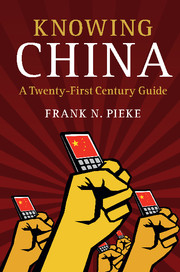Book contents
- Frontmatter
- Dedication
- Contents
- Preface
- Main Events in China, 1976–2015
- 1 Introduction: Knowing China
- 2 Why the Communist Party Will Not Fall from Power
- 3 China's Economy Will Continue to Grow, but Not Forever
- 4 Freedom without Universal Human Rights
- 5 From Empire to Nation, or Why Taiwan, Tibet and Xinjiang Will Not Be Given Independence
- 6 Not Just a Chinese Century
- 7 Conclusion: The Communist Party and China's Future
- Further Reading
- References
- Index
7 - Conclusion: The Communist Party and China's Future
Published online by Cambridge University Press: 05 July 2016
- Frontmatter
- Dedication
- Contents
- Preface
- Main Events in China, 1976–2015
- 1 Introduction: Knowing China
- 2 Why the Communist Party Will Not Fall from Power
- 3 China's Economy Will Continue to Grow, but Not Forever
- 4 Freedom without Universal Human Rights
- 5 From Empire to Nation, or Why Taiwan, Tibet and Xinjiang Will Not Be Given Independence
- 6 Not Just a Chinese Century
- 7 Conclusion: The Communist Party and China's Future
- Further Reading
- References
- Index
Summary
For China to meet both reform and post-reform challenges, the continued rule of the Communist Party is not the main obstacle, but instead, the most important condition. This involves much more than merely the routine, and in itself correct, observation that CCP rule keeps China united and ensures stability and peace. Designing and implementing the necessary policies demands the kind of skill, organization, staying power and legitimacy that only the Communist Party possesses. Although this assessment runs counter to the view that the problems and issues that China faces are inherent to fundamental flaws of the system that must eventually bring communism to its knees, it is intended neither as a whitewash for these problems, nor as a denial that the Party can, and indeed must do a lot better than at present.
The CCP's development can be divided in three distinct phases, each with its own characteristics, strengths and weaknesses. Twice has the Party needed to reinvent itself fundamentally to survive. Twice has it done so successfully, the first time between 1935 and 1942 and the second time between 1989 and 1992. Between its foundation in Shanghai in 1921 and the rectification in Yan'an in 1942, the CCP was a revolutionary party that was fragmented, ideologically divided and at the mercy of forces more powerful than itself: Stalin and the Comintern, warlords, the Nationalist Party and the Japanese army. After his arrival in Yan'an at the end of the Long March in 1935, Mao Zedong turned the Party into a personal dictatorship, a military machine and a totalitarian organization that defeated its enemies and transformed China into a communist state. Maoist dictatorship subsequently also destroyed many of the gains of the revolution, ultimately leaving China poor, weak and divided. Many aspects of communist dictatorship were changed during the first decade of reform in the 1980s, but a new phase in CCP politics and organization only really got underway after the crackdown on the Tian'anmen Movement in 1989 and Deng Xiaoping's Southern Tour in 1992. A unique blend of socialist authoritarianism and liberalization has grown out of this, changing China into an economic powerhouse and emerging global power.
This book has documented and discussed many aspects of this transformation. China has now moved beyond the project of the reform of state socialism to what I have termed neo-socialism.
- Type
- Chapter
- Information
- Knowing ChinaA Twenty-First Century Guide, pp. 171 - 177Publisher: Cambridge University PressPrint publication year: 2016



